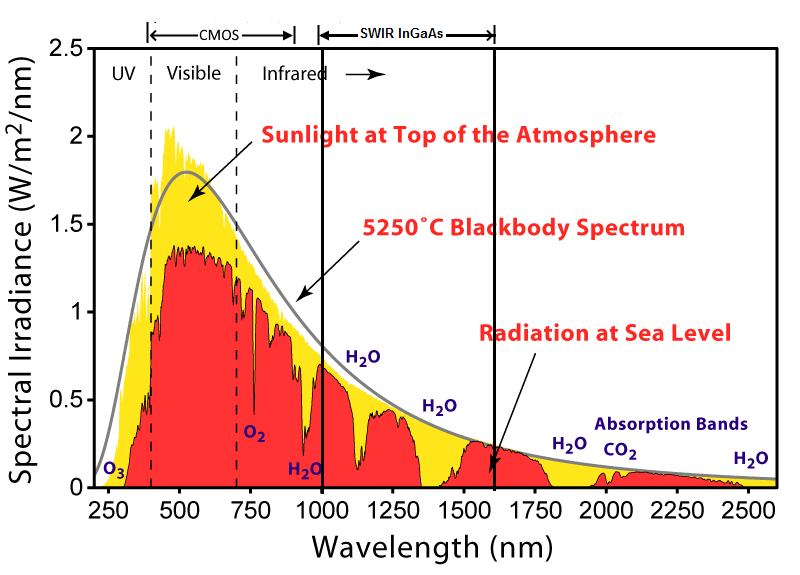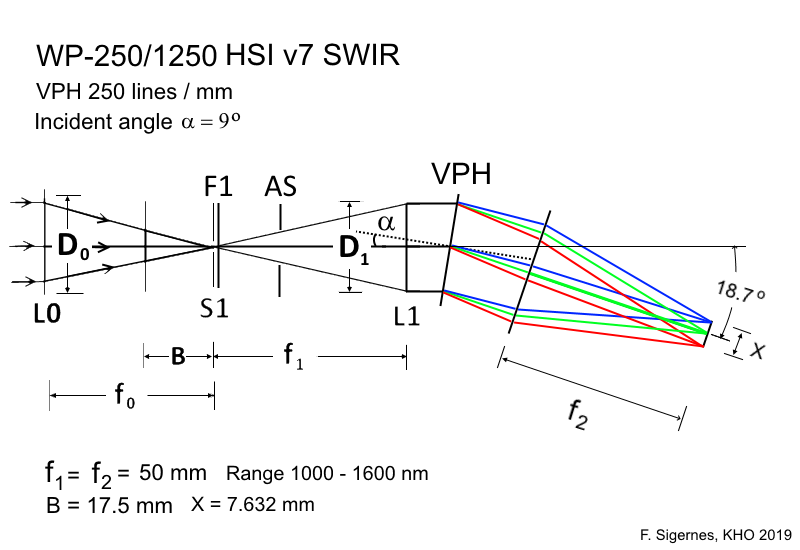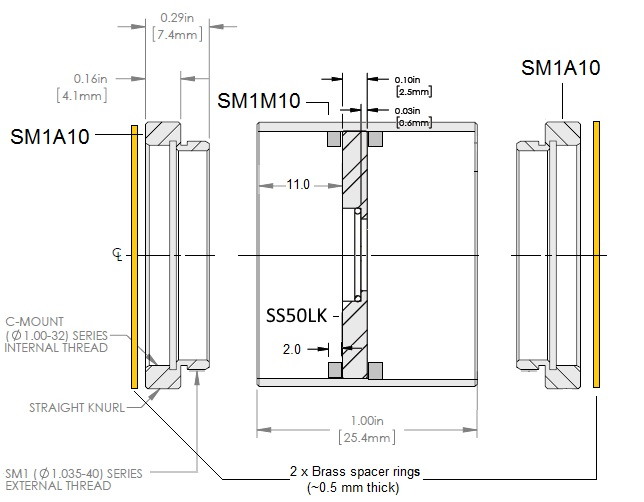| ☰ Menu | Preliminary design plan |
1 The University Centre in Svalbard (UNIS), Norway
2 Norwegian University of Science and Technology (NTNU), Trondheim, Norway
3 University of Oslo, Oslo, Norway

First, the source illumination in the SWIR region can be identified in Figure 1. The wavelength region 1000 - 1600 nm is roughly less than 50% in intensity compared to the visible part of the spectrum and dominated by two atmospheric water absorption bands.
The detector is an industrial camera using an InGaAs (iridium gallium arsenide) image sensors from the company Pembroke Instruments.

The optical diagram is shown in Figure 2. A 250 lines/mm Volume Phase Holographic (VPH) grating is the key element. The efficiency is above 50% for the wavelength region 1000 - 1600 nm. The effective aperture may be set to D0 = D1 = 24 mm which corresponds to ~ F/2. The input slit width is fixed with no magnification or demagnification of the height (h = 10 mm). A slit width of w = 50 µm will result in a first order spectral bandpass (FWHM) of approximately 4 nm.

The above parts are sufficient to create a prototype hyper spectral imager. All parts may now be embedded into a 3D printed design or a metal housing according to the angles and positions defined in the optical diagram. Note that a 90-degree mirror can be used between the collimator and the grating to make the design more compact in size.
| Item | Part / links | Description | Qty | Cost $ |
| 1 | Kowa LM50HC-SW | 50 mm SWIR C-mount Objective | 3 | 4347 |
| 2 | Thorlabs SM1A10 | Adapter ring SM1 - C- mount internal | 2 | 44 |
| 3 | Thorlabs SM1M10 | SM1 lens tube 1 inch long with internal threads | 1 | 17 |
| 4 | Thorlabs S50LK | Fixed high precision mounted slit | 1 | 120 |
| 5 | Thorlabs SM1RC | Slip Ring - SM1 tubes | 1 | 27 |
| 6 | Thorlabs Spacer Rings | Thorlabs C-mount 0.25-2mm space ring kit | 1 | 119 |
| 7 | WP-250/1250-xx | Volume Phase Holographic (VPH) grating | 1 | 625 |
| 8 | Pembroke Instruments | SWIR NIT InGaAs sensor (12.8 x 10.24) mm2 | 1 | 29 065 |
| 9 | 3D printer material | PRUSA Jet Black PETG filament | 1 | 27 |
| Total | 11 | 34 391 |
Table 1. Detailed part list HSI v7 SWIR.
- Fred Sigernes, Mikko Syrjäsuo, Rune Storvold, João Fortuna, Mariusz Eivind Grøtte, and Tor Arne Johansen, Do it yourself hyperspectral imager for handheld to airborne operations, Opt. Express 26, 6021-6035 (2018), https://doi.org/10.1364/OE.26.006021
- M. E. Grøtte, R. Birkeland, E. Honore-Livermore, S. Bakken, J. L. Garrett, E. F. Prentice, F. Sigernes, M. Orlandic, J. T. Gravdahl, T. A. Johansen, Ocean Color Hyperspectral Remote Sensing with High Resolution and Low Latency - the HYPSO-1 CubeSat Mission, IEEE Trans. Geoscience and Remote Sensing, Vol. 60, pp. 1-19 (2022), https://doi.org/10.1109/TGRS.2021.3080175
- M. Henriksen, E. Prentice, C. van Hazendonk, F. Sigernes, and T. Johansen, Do-it-yourself VIS/NIR pushbroom hyperspectral imager with C-mount optics, Opt. Continuum 1, 427-441 (2022), https://doi.org/10.1364/OPTCON.450693
- S. Bakken, M. B. Henriksen, R. Birkeland, D. D. Langer, A. E. Oudijk, S. Berg, Y. Pursley, J. L Garrett, F. Gran-Jansen, E. Honore- Livermore, M. E. Grøtte, B. A. Kristiansen, M. Orlandic, P. Gader, A. J. Sørensen, F. Sigernes, G. Johnsen and T. A. Johansen, HYPSO-1 CubeSat: First Images and In-Orbit Characterization, Remote sensing, 15(3), 755 (2023), https://www.mdpi.com/2072-4292/15/3/755
- Post by Harron, All you need to know about Solar Radiation, http://synergyfiles.com/2016/05/solar-radiation/